Customer satisfaction: deciding to fix, replace or throw
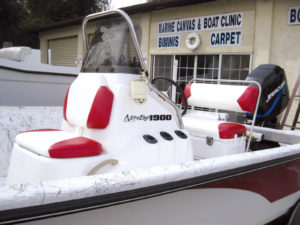
New foam is good insurance that the upholstery looks its best and the customer is comfortable.
The first rule in selling a product or service is to listen to the customer’s wants and needs. Then try to figure out a way to satisfy those wants and needs. This seemed to be a much easier task before the economic hiccup that we have endured.
Years ago, doing a bid for upholstery was simple. You measured the entire boat, found the right fabric, got a signed contract, did the job and got paid. Alas, as the times change, we need to change too.
One of the changes our shop has been dealing with throughout the economic slump has been an increase in customers wanting to fix up old stuff. I’m not talking about restoring a beautiful antique—I’m talking more like really old junk. A lot of things that people should throw away, they are trying to salvage. As fabricators, our job is to decide when “old” has become “too old.”
Don’t let the profit on one small project jeopardize your business. This couldn’t be more important than when you are dealing with a Captain’s seat. We have potential customers bringing in seats that they have purchased at flea markets or online sites. They are so pleased with the “deal” they got. Then we inspect the seat and have to give them the bad news. The t-nuts have rusted completely out so there is no way to mount the seat to the base. Or the bottom is cracked and it is too weak to use. Sure, we could just screw it down, but how safe is it? Would you want to be in that seat when the water got rough? Would you want a loved-one in that seat?
We have boat owners who come in with just one or a few of the cushions off their boat, often wanting to replace only the worst of the upholstery because they are trying to sell the boat and they don’t have the funds to do all of the upholstery.
Even though none of us likes to do just a part of a project, it can lead to more work from the new owners. We place small labels with our company name and phone number on every cushion we work on. We frequently get calls from the new owners to have the rest of the boat done. I have learned to keep good records of the fabrics used on these small cushion jobs in case the rest of the boat interior eventually comes back to us.
Labor is generally the largest part of any upholstery job. We will recommend to our customers to purchase enough fabric for the entire boat. This way they can bring in a couple of cushions at a time and proceed to bring in the rest of the upholstery as they can afford to without a fabric match concern.
For most of my upholstery career, I rarely used the existing foam. New foam was good insurance that the upholstery would look its best and my customers would be comfortable. I didn’t have to worry about the green stuff from the foam moving into the new vinyl. Recently, I have had to re-evaluate that step. I am doing more patching of foam than I ever did before—if the application is appropriate, of course. For example:
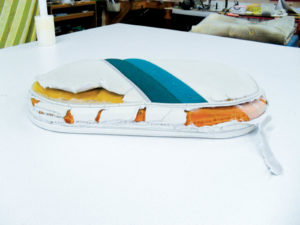 The boat owner wanted this single cushion repaired. The foam was the first hurdle to clear. He didn’t want to spend a lot of money, but, naturally, he wanted it to look good.
The boat owner wanted this single cushion repaired. The foam was the first hurdle to clear. He didn’t want to spend a lot of money, but, naturally, he wanted it to look good.
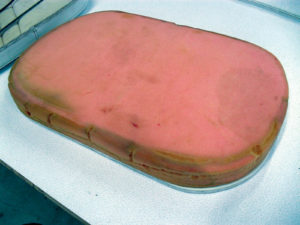 This is the foam after the fabric has been removed and steamed. I was going to attach ½-inch foam to the top so I didn’t need a perfectly smooth surface.
This is the foam after the fabric has been removed and steamed. I was going to attach ½-inch foam to the top so I didn’t need a perfectly smooth surface.
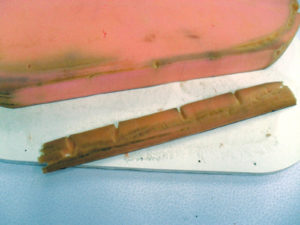 After measuring the depth of the grooves that were ruined by the sun, I found that ¼-inch cut off the front edge would remove most of the bad stuff.
After measuring the depth of the grooves that were ruined by the sun, I found that ¼-inch cut off the front edge would remove most of the bad stuff.
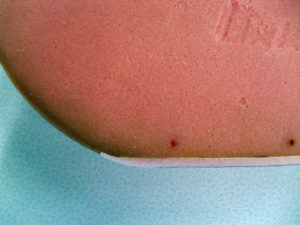 The new ¼-inch foam is glued on and shaped with a band saw to blend the curve.
The new ¼-inch foam is glued on and shaped with a band saw to blend the curve.
Estimate how long it is going to take to repair the foam versus the cost of replacement. The results may truly surprise you. Are you spending 90 minutes to fix a piece of foam that would have cost your customer $30? Don’t short yourself by not figuring your labor as a significant cost.
Many years ago while visiting my grandmother, I was rambling on about how busy we were with work. She listened for a while, and then asked me, “are you busy or are you profitable?” That question has never escaped me.
I am hoping that we are all profitable this year.
Carol Racine is owner of Racine Design in Jacksonville, Fla.
 TEXTILES.ORG
TEXTILES.ORG 


